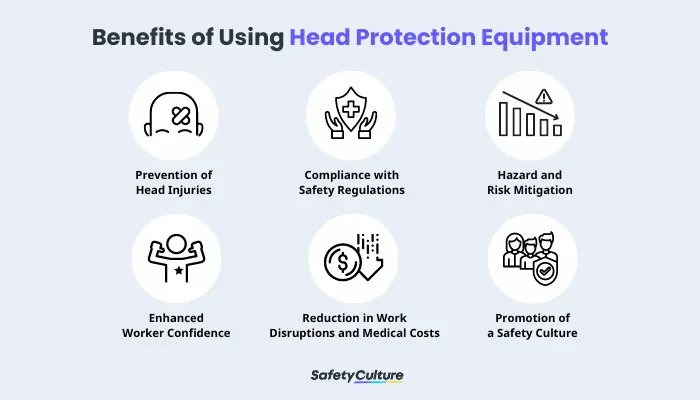What is Head Protection Equipment?
Head protection equipment refers to various types of safety gear designed to protect the head and mitigate the risk of head injuries in the workplace. It’s typically made from durable materials that can withstand impacts and provide a level of cushioning and shock absorption. Its design and construction may vary depending on the nature of the hazards involved and the specific industry, such as construction, manufacturing, and warehouse settings.
Why Use Head Protections?
In certain industries, workplace safety hazards are more prevalent and the dangers that workers can be exposed to are more significant. Hence, organizations in these fields must enforce strict Personal Protective Equipment (PPE) safety to help protect their employees at all times.
For example, the construction industry accounts for the greatest number of fatal and non-fatal work-related Traumatic Brain Injuries (TBI), according to the Centers for Disease Control and Prevention (CDC). This is mainly attributed to the nature of construction workers’ tasks and work environment where they can be struck by falling or flying objects.

Benefits of Using Head Protection Equipment
Hence, the primary purpose of head protection equipment, an example of protective equipment or PPE, is to provide a barrier between the head and minimize the risk or impact of safety hazards. Apart from that, the following are some key reasons why head protection safety must be prioritized:
- Prevention of Head Injuries
- Compliance with Safety Regulations
- Hazard and Risk Mitigation
- Enhanced Worker Confidence
- Reduction in Work Disruptions and Medical Costs
- Promotion of a Safety Culture
By incorporating head protection into a broader safety framework that includes eye protection, respiratory protection, and other relevant PPE requirements, employers can ensure a comprehensive worker safety program.
Further, it’s important to note that many industries, countries, and regions have specific safety regulations that mandate the use of head protection equipment in particular work environments. Some examples are the following:
- US Occupational Safety and Health Administration (OSHA)
- AS / NZS 1801 Occupational Protective Helmets – Western Australia
- UK Health and Safety Executive – Construction
Health and Safety Dangers of Not Wearing Proper Head Protection
Potential hazards of not wearing proper protective equipment involved in various work, such as falling objects, impacts from machinery or equipment, low ceilings, or electrical hazards, can cause serious injuries to the head since it’s a vulnerable part of the body. These include the following:
- Traumatic Brain Injuries (TBIs) – These can result in long-term or permanent damage to the brain, affecting cognitive function, memory, motor skills, and overall quality of life.
- Concussions – A common type of head injury that can occur from sudden impacts or blows to the head, concussions can lead to a range of symptoms, including headaches, dizziness, confusion, memory problems, and sensitivity to light or noise.
- Skull Fractures – These are severe injuries that occur when the bones of the skull are broken and can result from high-impact forces or direct blows to the head.
- Eye and Face Injuries – Neglecting head protection can also increase the risk of eye and face injuries which can lead to vision impairment or blindness and disfigurement.
- Psychological and Emotional Impact – Sustaining a head injury can cause anxiety, depression, post-traumatic stress disorder (PTSD), and other mental health issues.
- Legal and Financial Consequences – Non-compliance with safety regulations can lead to legal penalties, fines, and lawsuits, along with the costs associated with medical treatment, rehabilitation, worker compensation claims, and potential lawsuits.
What are the Different Types of Head Protection?
Several types of head protection equipment are available and designed to suit various work environments and hazards. Also, various head PPEs have unique classes and categories, and it’s important for you to know which best fits your needs. Here are some common types being used in different occupations:
Hard Hats
Hard hats are widely used in construction, industrial, and manufacturing settings. They typically feature a rigid outer shell made of High-Density Polyethylene (HDPE) or other durable materials. Often, this type of hat has a suspension system inside that helps absorb and distribute impact forces to provide protection against falling objects, impacts from machinery, and low ceilings.
Helmets
Helmets are more specialized head protection gear designed for specific industries or activities. They offer more comprehensive protection than hard hats and may have additional features tailored to particular hazards. Some examples include the following:
- Firefighting Helmets – Firefighters use helmets specifically designed for their profession. These helmets provide protection against heat, flames, falling debris, and impact during firefighting operations.
- Industrial Helmets – Industrial helmets are designed for workers in industries such as oil and gas, construction, and utilities. They often have accessories like face shields, hearing protection, or integrated communication systems to provide comprehensive protection in hazardous work environments.
- Motorcycle Helmets – Some workers use motorcycles in their jobs (e.g., food delivery riders and couriers) to help protect their head and face. Along with other PPEs, helmets must be used to promote motorcycle safety.
- Sports Helmets – Sports helmets are designed for various athletic activities, including football, biking, skiing, or rock climbing. These helmets are specialized to provide impact protection and may have additional features such as visors, ventilation systems, or customizable padding.
Bump Caps
Bump caps are designed to provide limited protection against minor bumps, scrapes, and lacerations. They are often used in industries where workers may encounter low-hanging objects or overhead obstructions, such as maintenance or warehouse environments. However, bump caps are unsuitable for heavy falling objects or high-impact hazards.
Welding Helmets
These are specialized headgear designed to protect against the intense heat, sparks, and radiation generated during welding. They typically feature a dark-tinted visor to shield the eyes and face from the bright welding arc. Also, they may have additional respiratory protection for filtering harmful fumes.
Electrically Insulating Helmets
Workers in electrical industries use electrical PPE, including electrically insulating helmets. These are made from materials that do not conduct electricity and provide insulation to reduce the risk of electrical shock.
What Should You Consider When Choosing the Type of Head Protection You Use?
When choosing the type of head protection to use, several factors should be considered to ensure that it effectively addresses the specific hazards in the work environment. Make sure to keep these in mind:
- Hazard Assessment – Consider potential hazards such as falling objects, impacts from machinery, low ceilings, electrical hazards, or exposure to extreme temperatures by conducting a thorough hazard assessment of the workplace.
- Regulatory Compliance – Ensure that the selected head protection equipment complies with relevant safety regulations and standards applicable to your industry or region.
- Type of Protection Needed – Evaluate the level of protection required based on the identified hazards.
- Comfort and Fit – Consider adjustable suspension systems, chin straps, and headband padding options that provide a customizable fit and optimal comfort to encourage workers to wear the headgear consistently.
- Climate and Environmental Factors – Take into account the climate and environmental conditions in the work area, including ventilation, temperature, and exposure to moisture.
- Compatibility with Other PPE – Ensure that the head protection can be effectively combined with other safety equipment required to complete the job.
- Quality and Durability – Consider choosing head protection equipment from reputable manufacturers or suppliers that produce or sell high-quality products.
- Training and User Acceptance – Consider the ease of use and training requirements associated with the selected head protection. Workers should receive proper training on the correct use, adjustment, and maintenance of the equipment.
- Inspection and Maintenance Requirements – Establish measures in place to regularly inspect and replace equipment when signs of wear or damage are observed.
Create Your Head Protection PPE Inspection Checklist
Eliminate manual tasks and streamline your operations.
Get started for FREE



